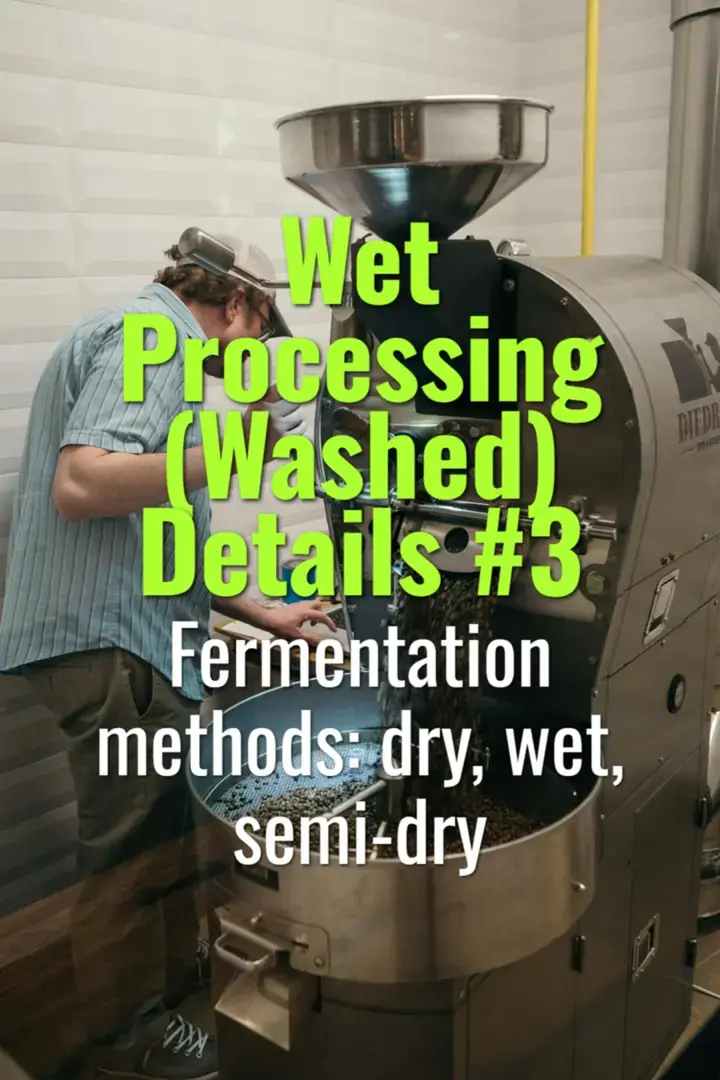Fermentation methods: dry, wet, semi-dry
This topic explains the three main fermentation methods used in washed coffee—dry, wet, and semi-dry—how they differ, their effects on processing efficiency, and their influence on flavor outcomes.
- Coffee Basics Nerds
- 2 min read
Article 3 of 12 in Wet Processing (Washed) Details/

Role of Fermentation in Coffee Processing
- Fermentation breaks down sticky mucilage left on beans after depulping.
- Naturally occurring yeasts and bacteria drive this process.
- Correctly managed fermentation ensures clean cup quality and avoids defects.
Fermentation Methods
1. Dry Fermentation
- Process: Beans with mucilage are placed in fermentation tanks without added water.
- Duration: 12–36 hours depending on temperature and altitude.
- Advantages:
- Uses little or no water.
- Intensifies fruity notes in some coffees.
- Challenges:
- Requires careful monitoring to prevent over-fermentation.
- Flavor outcomes: Clean, bright acidity, sometimes fruit-forward complexity.
2. Wet Fermentation
- Process: Beans submerged in tanks filled with water.
- Duration: 24–72 hours depending on climate.
- Advantages:
- Water moderates temperature, making process more predictable.
- Helps separate lighter defective beans that float.
- Challenges:
- Requires large amounts of clean water.
- Wastewater treatment essential to avoid pollution.
- Flavor outcomes: Very clean cup profiles, high clarity, pronounced acidity.
3. Semi-Dry (Intermediate) Fermentation
- Process: Small amount of water added to beans in tanks—between dry and wet methods.
- Duration: 18–48 hours.
- Advantages:
- Reduces water use compared to full wet fermentation.
- Provides more control than fully dry fermentation.
- Challenges:
- Still requires monitoring to avoid inconsistent outcomes.
- Flavor outcomes: Balanced cups—clean but with added sweetness/body compared to wet fermentation.
Monitoring & Endpoints
- Fermentation endpoints judged by texture (mucilage no longer sticky) or by measuring pH (target ~4.2–4.5).
- Over-fermentation → sour, alcoholic defects.
- Under-fermentation → mucilage residue and dirty flavors.
Lasting Importance
The choice between dry, wet, and semi-dry fermentation shapes the balance of clarity, sweetness, and body in the final cup. By understanding and controlling these methods, producers can adapt to resource availability and market preferences while maintaining quality.
You might also like:
- Tags:
- Lasting Importance
- Cup Quality
- Flavor Outcomes
- Sweetness Body
- Cup Profiles
- Challenges Requires
- Bright Acidity
- Requires Careful
- Clean Water
- Fruit Forward
- Clarity Sweetness
- Clean Bright
- Coffee Processing
- Clean Cup
- Balance Clarity
- Defective Beans
- Fermentation Tanks
- Final Cup
- High Clarity
- Naturally Occurring
- Fruity Notes
- Balanced Cups
- Hours Depending
- Sticky Mucilage
- Yeasts Bacteria